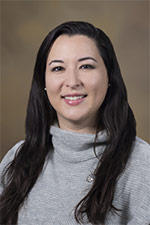UA Program Teaches Mindfulness to Combat Obesity Among Latino Youth in Arizona
Reducing toxic stress to prevent chronic diseases such as obesity and diabetes in children living in both rural and urban communities in Arizona is the focus of a pilot study by researchers at the University of Arizona Mel and Enid Zuckerman College of Public Health.
Toxic stress occurs when life’s demands consistently outpace our ability to cope with those demands – and it is particularly harmful to children. According to the Centers for Disease Control and Prevention, toxic stress has been linked to risky health behaviors, chronic health conditions, and early death.
“Saludable” (Healthy) is a six-week prevention and intervention program designed for children ages 8-13 to tackle the link between toxic stress and obesity in Latino children living in both Pima and Maricopa counties. The curriculum focuses on three areas of health and well-being: nutrition, physical activity (in the form of yoga), and mindfulness-based stress reduction (MBSR) techniques.
MBSR is a structured group program that uses mindfulness meditation to improve well-being and alleviate suffering.
“In this pilot program we want to find out if mindfulness will help these children manage stress and anxiety,” said Celina I. Valencia, DrPH, postdoctoral research associate in the Division of Public Health Practice and Translational Research at the UA Zuckerman College of Public Health – Phoenix.

Celina I. Valencia, DrPH
The children meet once a week at their local community center or library for an hour-long class. Each child receives health screenings for weight, height, blood pressure, cholesterol and blood glucose.
Dr. Valencia said that food security is the biggest stressor for the children living in Aguila, a rural farming community in Maricopa County where the closest supermarket is a 30-minute drive.
“Most of these kids don’t always know where their next meal is coming from. They rely on free lunch programs in school and the local food bank,” Dr. Valencia said.
“There is a relationship between food instability and obesity. It sounds counter intuitive, and we don’t know if it has something to do with portion control. When meals are unpredictable and food is scarce, over-eating may occur when a child does have access to food. But, we do know food scarcity is stressful.”
The pilot study seeks to serve children in the same communities the UA College of Public Health works with through its “Juntos Por la Salud” (Together For Health) Primary Prevention Mobile Health Unit, another community-based program. Directed by Cecilia Rosales, MD, MS, associate dean and professor of the UA Mel and Enid Zuckerman College of Public Health – Phoenix, the mobile health units provide free health screening assessments, health education, and referrals to people who don’t have health insurance in Maricopa and Pima counties.
The public health student facilitators involved with the Saludable program work directly with the children. They receive training on how to conduct health screenings by the staff of the mobile health units.
Dr. Valencia says the students are getting real-world research experience from their involvement in the pilot study that addresses the national and global health crisis of childhood obesity and diabetes at the community level.
“Saludable has been an enriching experience that I will carry with me not only for the remainder of my public health career, but for the rest of my life,” said Sahaj Singh, a facilitator and student in the master of public health program.
“The children of Aguila have touched my heart with their honesty and their innocence. They have made an impact on my life that has opened my eyes to the scarcity of health care in rural communities throughout the United States. I enjoyed teaching the kids yoga and witnessing the kids relish the mindfulness breathing and relaxation techniques. I hope that we can continue to work with this community and possibly others that could gain from this beneficial program,” Singh added.
Erin Pelley, a public health undergraduate student, considers her role as a program facilitator to be an “incredible opportunity” to grow as a future public health professional.
“I was able to learn about all of the steps needed to make a pilot program successful, specifically when researching in a community setting. I also learned about the challenges faced by rural populations through working directly in the community. Latino children are a population with unique assets and needs, and Saludable allowed me to learn methods to effectively communicate health topics to these kids. Seeing the difference that mindfulness and health education made on the children’s emotional and physical well-being affirmed my passion for this work,” Pelley added.
William Dudley, branch manager for the Aguila Library in Maricopa County, calls the the Saludable program a fun spin on health information.
“It opened the door for kids at the Aguila Library into aspects of individual health in terms of what healthful choices are and how important healthful habits are in the long haul. In rural communities such as Aguila, where doctors and other health practitioners are many miles away, informed healthful habits take on an incontrovertible urgency. I’m thankful the kids had that urgency clarified in a digestible way,” Dudley added.
The Saludable pilot study is funded by several grants for a total of $60,000 from the Arizona Area Health Education Centers, the Association of Schools and Programs of Public Health, and the Canyon Ranch Center for Prevention and Health Promotion.
"I believe we are the first to use mindfulness-based stress reduction for children in a community-based program. Most mindfulness programs happen in a school environment where you have a captive audience. The kids we are working with come to us through their local community center or library,” Dr. Valencia said.
She plans to refine the curriculum for the program based on what they learn with each group of children and expand to other communities throughout Arizona.

